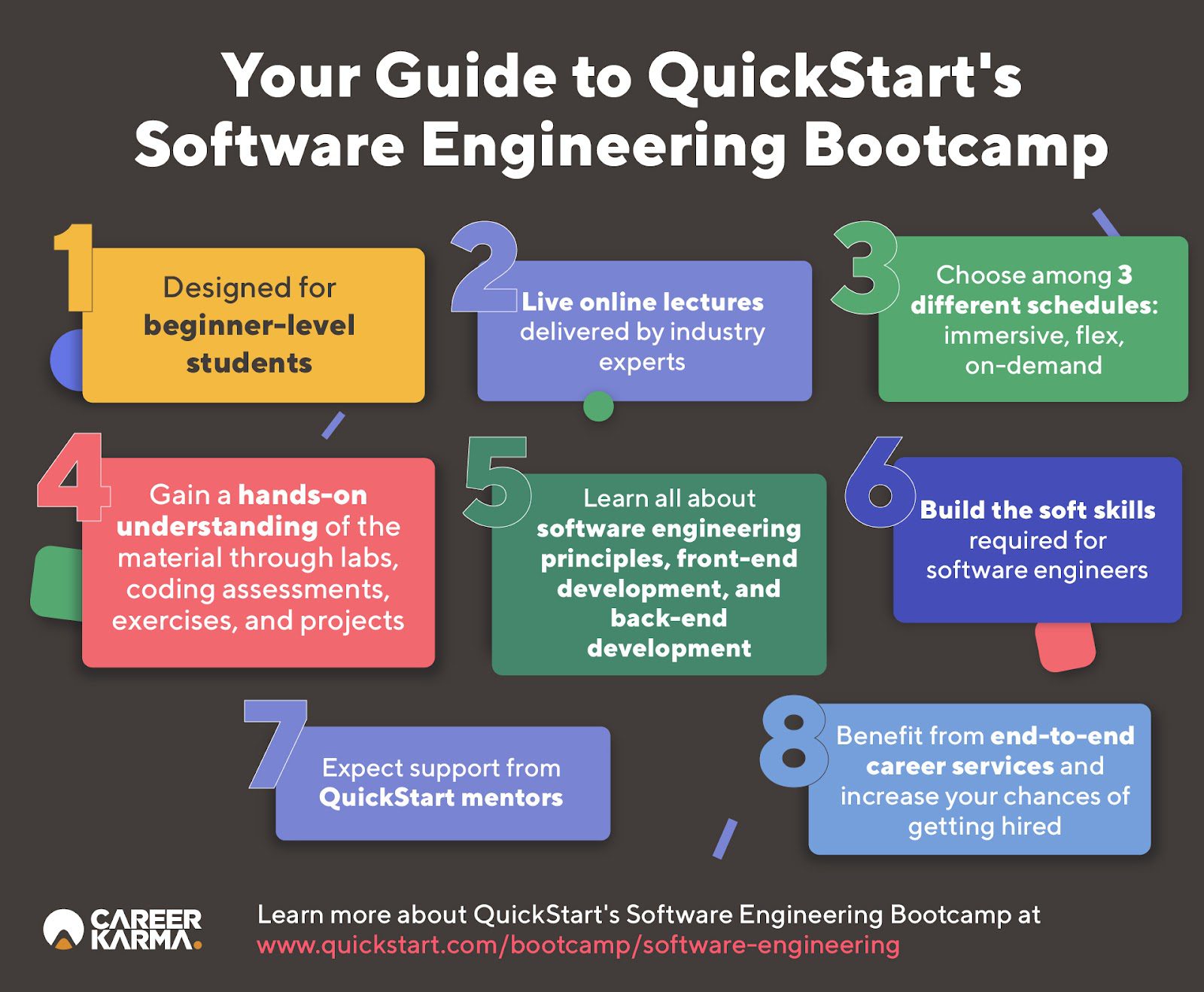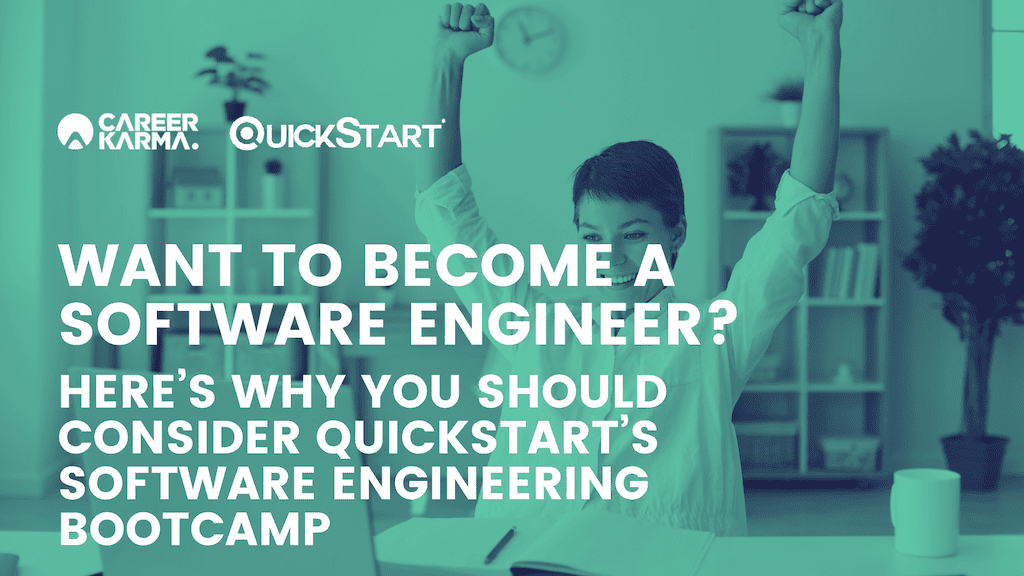Opportunities for aspiring software engineers still run aplenty in 2023, according to the US News & World Report, which declared software development as this year’s best occupation. Indeed, data from the US Bureau of Labor Statistics reveals that software engineering jobs are expected to grow 25 percent by 2031. That’s five times faster than the average growth rate of 5 percent across occupations. Put another way, the software engineering industry will be seeing the addition of over 400,000 jobs by the end of the decade.
So, what does this mean for you?
Well, if you are looking to enter the software industry, then software engineering offers prime opportunities for you. Even better, there are more accessible and affordable ways to break into the industry now that don’t involve returning to school for four years or spending thousands of dollars per year.
Tech training provider QuickStart gives you that option through its brand-new Software Engineering Bootcamp. The bootcamp program joins the ranks of QuickStart’s renowned skills training programs in cybersecurity, cloud engineering, AI/machine learning, and data science and analytics.
But there are already tons of coding bootcamps out there, you say? We sat down with Ivor Bokun, Director of the Product Department at QuickStart, to find out what makes QuickStart’s Software Engineering Bootcamp stand out.
A Review of QuickStart’s Software Engineering Bootcamp

QuickStart’s Software Engineering Bootcamp is a 23-week program that provides in-depth instruction on the key competencies employers look for in software engineers. Its key features include the following:
- Low Barrier to Entry. QuickStart’s Software Engineering Bootcamp is designed for beginner-level students. That means you can join the program even if you have little to no coding expertise or IT experience. As Bokun says, “There are no prerequisites besides using a computer. You will learn everything as you go along, and you will have a lot of help [along the way].”
- Live Online Lectures. Every week, you will attend live online lectures on the QuickStart learning platform so you get to interact with your instructors and peers. The learning materials and curriculum are developed by subject matter experts in the IT industry.
- Virtual Instructions in Your Preferred Format. To make the Software Engineering Bootcamp accessible for everyone, QuickStart offers virtual instructions in three formats: immersive, flex, or an on-demand bootcamp. The immersive bootcamp includes two 2-hour live sessions per week. The flex bootcamp offers one 2-hour live session per week, whereas the on-demand learning format gives you five 30-minute coaching sessions that you can complete at your own pace.
- Practical Learning. Your learning will not be limited to lectures. Rather, you will also learn by completing hands-on labs, coding assessments and exercises, and five projects. These practical tasks are designed to enhance your technical knowledge and provide you with opportunities to apply your knowledge in a real working environment.
- Learn from Mentors. The provided mentor support during the bootcamp will ensure successful program completion to best prepare the student for their certification exam. Expect support from QuickStart mentors, who also work at top software engineering companies. “You will have weekly mentoring sessions where you can ask questions or share your concerns about your projects with the mentors,” adds Bokun.
- Career Services. Every QuickStart student will have four 30-minute sessions with a career counselor. You will also learn about what it takes to build an optimized résumé and LinkedIn profile, ace job interviews, and develop robust portfolios with front-end and back-end projects displayed to recruiters. Lastly, you will learn how to identify internship opportunities that match your skills and interest and get connected with QuickStart’s hiring partners.
Now that you know the key features of QuickStart’s Software Engineering Bootcamp, let’s dive into the curriculum and take a peek at what you will learn throughout the program.
QuickStart introduces its Software Engineering Bootcamp to complement its other well-known programs in cybersecurity, cloud engineering, AI/machine learning, and data science and analytics.
Learn more here!What Will You Learn?
QuickStart’s Software Engineering Bootcamp covers the latest coveted skills in the software engineering market. In other words, the skills you’ll learn are the skills you’ll need to perform your day-to-day job as a software engineer.
As Bokun shares, “You need to know how to write clean code, and you need to know how to read code from somebody else. So altogether, we are trying to develop students into experts in this area who are going to have the skills and concepts that can be applied in software engineering or software developer roles easily.”
To that effect, the curriculum consists of three parts: software engineering principles, front-end development, and back-end development.
Fundamentals of Software Engineering
The bootcamp opens with computer science and software engineering fundamentals, which are vital especially if you have zero prior software engineering experience. This, according to Bokun, is where you’ll learn the answers to the following questions:
- What is the software development life cycle all about?
- What are data structures?
- What are algorithms?
- How do you approach code lines or programs with more than thousands of code lines?
“It’s going to be much tougher for you to learn something new [if] you lack the fundamental skills,” says Bokun.
Front-End and Back-End Development
The second part of the bootcamp explores front-end development, as you dive deeper into the principles of software engineering, data structures, and algorithms. The final phase is devoted to back-end development. “In this phase, students will work closely, and more with programming languages such as Python,” says Bokun. “They’re going to use SQL [and] how to connect data with front-end applications.”
Below are a few key tools and technologies you’ll cover when you enroll in the program.
- CompTIA IT Fundamentals+ provides an introduction to basic IT knowledge and skills.
- HTML and CSS are two of the fundamental tools for creating web pages. HTML provides the page structure, while CSS handles the visual and auditory layout.
- JavaScript is a dynamic, object-oriented prototypical programming language.
- React Redux is an open JavaScript library designed to manage the state of JavaScript applications. It is most often used together with React or Angular to build user interfaces.
- Python Django is a high-level open Python framework for developing web systems.
- SQL is a declarative programming language for user interaction with databases.
- UX and Product Management should work closely together to make things that perfectly serve the demands of the users.
- Bootstrap is a free and open-source toolkit for building websites and web applications.
Soft Skills for Software Engineers
Besides learning hard skills, you will also build the soft skills required for software engineers. “Software engineers work in teams. So you need to know how to communicate with other team members,” says Bokun. “You need to know how to organize your projects.” That’s why several modules in the curriculum involve topics such as Agile and Scrum methodology.
Immerse Yourself Into Software Engineering with QuickStart
As mentioned, software engineering is slated to see above-average growth in job opportunities in the next decade. If you are keen to enter this field but don’t have the skills or knowledge, QuickStart’s Software Engineering Bootcamp can pave the best path for you.
Ready to get the ball rolling? Simply schedule a call with QuickStart’s Admissions Team and learn more about QuickStart’s Software Engineering Bootcamp!
About us: Career Karma is a platform designed to help job seekers find, research, and connect with job training programs to advance their careers. Learn about the CK publication.

